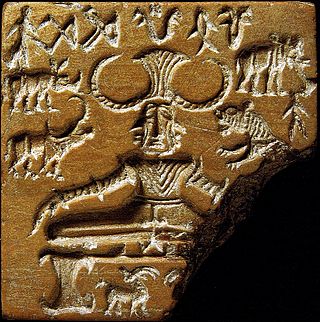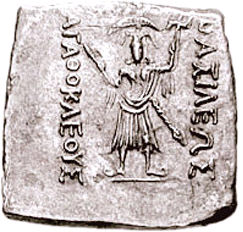Related Research Articles

Pradyumna is the eldest son of the Hindu deities Krishna and his chief consort, Rukmini. He is considered to be one of the four vyuha avatars of Vishnu. According to the Bhagavata Purana, Pradyumna was the reincarnation of Kamadeva, the god of love. The Mahabharata states that Pradyumna was a portion of Sanat Kumara.

Doris Helen Kearns Goodwin is an American biographer, historian, former sports journalist, and political commentator. She has written biographies of numerous U.S. presidents. Goodwin's book No Ordinary Time: Franklin and Eleanor Roosevelt: The Home Front in World War II won the Pulitzer Prize for History in 1995. Goodwin produced the American television miniseries Washington. She was also executive producer of "Abraham Lincoln,” a 2022 docudrama on the History Channel. This latter series was based on Goodwin's Leadership in Turbulent Times.

Doris Duke was an American billionaire tobacco heiress, philanthropist, and socialite. She was often called "the richest little girl in the world". Her great wealth, luxurious lifestyle, and love life attracted significant press coverage, both during her life and after her death.

Doris Adelaide Derby was an American activist and documentary photographer. She was the adjunct associate professor of anthropology at Georgia State University and the founding director of their Office of African-American Student Services and Programs. She was active in the Mississippi civil rights movement, and her work discusses the themes of race and African-American identity. She was a working member of the Student Nonviolent Coordinating Committee (SNCC) and co-founder of the Free Southern Theater. Her photography has been exhibited internationally. Two of her photographs were published in Hands on the Freedom Plow: Personal Accounts by Women in SNCC, to which she also contributed an essay about her experiences in the Mississippi civil rights movement.

Doris McCarthy, LL. D. was a Canadian artist known for her abstracted landscapes. In a 2004 interview with Harold Klunder, the artist remarked:
I was influenced very strongly by the tradition of going out into nature and painting what was there. I bought it. And I still buy it.

Aniruddha is a character in Hindu mythology, the son of Pradyumna and Rukmavati, and the grandson of Krishna and Rukmini. He is said to have been very much like his grandfather, to the extent that he is considered by some to be a Jana avatar, an avatar of Vishnu. He is a member of the chatur-vyuha, the four Vrishni heroes.

The Vrishnis were an ancient Indian clan who were believed to be the descendants of Vrishni. It is believed that Vrishni was the son of Satvata, a descendant of Yadu, the son of Yayati. He had two wives, Gandhari and Madri, not to be confused with Gandhari and Madri from the Mahabharata. He has a son named Devamidhusha by his wife Madri. Vasudeva, the father of Krishna was the grandson of Devamidhusha. According to the Puranas, the Vrishnis were residents of Dvaraka.

Doris Salcedo is a Colombian-born visual artist and sculptor. Her work is influenced by her experiences of life in Colombia and is generally composed of commonplace items such as wooden furniture, clothing, concrete, grass, and rose petals. Salcedo's work gives form to pain, trauma, and loss, while creating space for individual and collective mourning. These themes stem from her own personal history. Members of her own family were among the many people who have disappeared in politically troubled Colombia. Much of her work deals with the fact that, while the death of a loved one can be mourned, their disappearance leaves an unbearable emptiness. Salcedo lives and works in Bogotá, Colombia.

Vāsudeva, later incorporated as Vāsudeva-Krishna, Krishna-Vāsudeva or simply Krishna, was the son of Vasudeva Anakadundubhi, king of the Vrishnis in the region of Mathura. He was a leading member of the legendary Vrishni heroes, and may well have been a historical ruler in the region of Mathura.

Modern dance is a broad genre of western concert or theatrical dance which includes dance styles such as ballet, folk, ethnic, religious, and social dancing; and primarily arose out of Europe and the United States in the late 19th and early 20th centuries. It was considered to have been developed as a rejection of, or rebellion against, classical ballet, and also a way to express social concerns like socioeconomic and cultural factors.
Sharada SrinivasanFRAS FAAAS is an archaeologist specializing in the scientific study of art, archaeology, archaeometallurgy and culture. She is a Professor at the National Institute of Advanced Studies, Bangalore, India, and an Honorary University Fellow at the University of Exeter, UK. Srinivasan is also an exponent of classical Bharatanatyam dance. She was awarded India's fourth highest civilian award the Padma Shri in 2019. She is a member of the Calamur family.

Mallika Srinivasan is an Indian industrialist and is the chairman and managing director of Tractors and Farm Equipment Limited, a tractor major incorporated in 1960 at Chennai, India. She served as Chairperson of the Public Enterprises Selection Board (PESB) constituted by the Government of India from 1 April 2021 and served there till 18 November 2024. She is additionally on the Global Board of U.S.-India Business Council (USIBC), and the Boards of AGCO Corporation - United States. She is a core member of the BRICS Women's Business Alliance and a member of India-US CEO Forum. She is also the member on the Governing Body of Stella Maris College - Chennai.

The Pashupati seal, is a steatite seal which was uncovered in Mohenjo-daro, now in modern day Pakistan, a major urban site of the Indus Valley civilisation ("IVC"), during excavations in 1928–29, when the region was under British rule. The excavations were carried out by the Archaeological Survey of India, the official body responsible for preservation and excavation. The seal depicts a seated figure that is possibly tricephalic. The seated figure has been thought to be ithyphallic, an interpretation that has been questioned by many, but was still held by the IVC specialist Jonathan Mark Kenoyer in a publication of 2003. The man has a horned headdress and is surrounded by animals. He may represent a horned deity.
Vyūha means - 'to arrange troops in a battle array (formation)', 'to arrange, put or place in order, to dispose, separate, divide, alter, transpose, disarrange, resolve '. Its root is व्यः which means - a 'cover' or 'veil'. This word also refers to emanation and to the manifest power of Lord Vishnu. It has different meanings depending on the doctrine of the treatise and the context, such as revealing of the knowledge of Vedas, and the war formations of Mahabharata.

Over the millennia of its development, Hinduism has adopted several iconic symbols, forming part of Hindu iconography, that are imbued with spiritual meaning based on either the scriptures or cultural traditions. The exact significance accorded to any of the icons varies with region, period and denomination of the followers. Over time some of the symbols, for instance the Swastika has come to have wider association while others like Om are recognized as unique representations of Hinduism. Other aspects of Hindu iconography are covered by the terms murti, for icons and mudra for gestures and positions of the hands and body.

Doris Patty Rosenthal was an American painter, printmaker, designer, and educator, who made solitary explorations into remote areas of Mexico in search of indigenous peoples. Over several decades beginning in the 1930s, Rosenthal made hundreds of sketches in charcoal and pastel depicting the everyday life and domestic activities of Indian and mestizo peasant culture, which she later used to create large-scale studio paintings. Life magazine featured Rosenthal's art and travels in Mexico in a five-page spread in 1943.

The Vrishni heroes, also referred to as Pancha-viras, are a group of five legendary, deified heroes who are found in the literature and archaeological sites of ancient India. Their earliest worship is attestable in the clan of the Vrishnis near Mathura by 4th-century BCE. Legends are associated with these deified heroes, some of which may be based on real, historical heroes of the Vrishni clan. Their early worship has been variously described as cross-sectarian, much like the cult of the Yakshas, related to the early Bhagavata tradition of Hinduism, and with possible links to Jainism as well. They and their legends – particularly of Krishna and Balarama – have been an important part of the Vaishnava tradition of Hinduism.

Saṃkarṣaṇa later known as Balarama, was a son of Vasudeva Anakadundubhi, king of the Vrishnis in the region of Mathura. He was a leading member of the Vrishni heroes, and may well have been an ancient historical ruler in the region of Mathura. The cult of Saṃkarṣaṇa with that of Vāsudeva is historically one of the earliest forms of personal deity worship in India, attested from around the 4th century BCE.

The religion and belief system of the Indus Valley Civilisation (IVC) people have received considerable attention, with many writers concerned with identifying precursors to the religious practices and deities of much later Indian religions. However, due to the sparsity of evidence, which is open to varying interpretations, and the fact that the Indus script remains undeciphered, the conclusions are partly speculative and many are largely based on a retrospective view from a much later Hindu perspective.

Gaṇikā or ganika were female courtesans in early Ancient India, with their earliest reference in the Vedic period. Mentioned in the Kamasutra, Gaṇikās were also dubbed as "courtesans de luxe," this was how Indians in early Ancient India, separated them from veshyas, who were also courtesans.Moti Chandra, an Indian scholar who suggested that "In the hierarchy of courtesans, the kumbhadasi occupied the lowest place and the Gaṇikās the highest." This suggests that Gaṇikās, were not merely prostitutes or normal courtesans, but they were considered "premium courtesans." It is similar to how there is a difference between an Oiran and a Geisha.